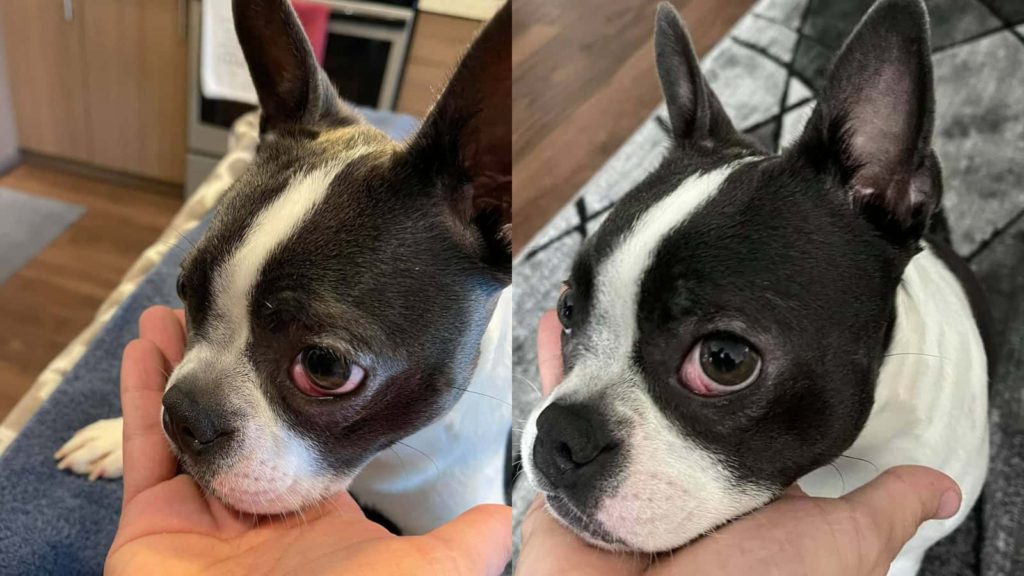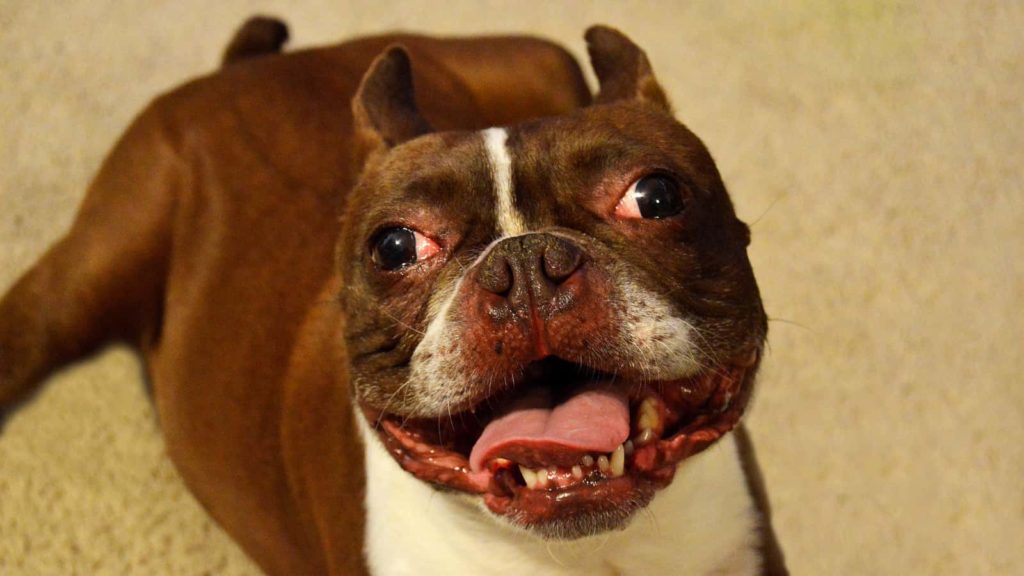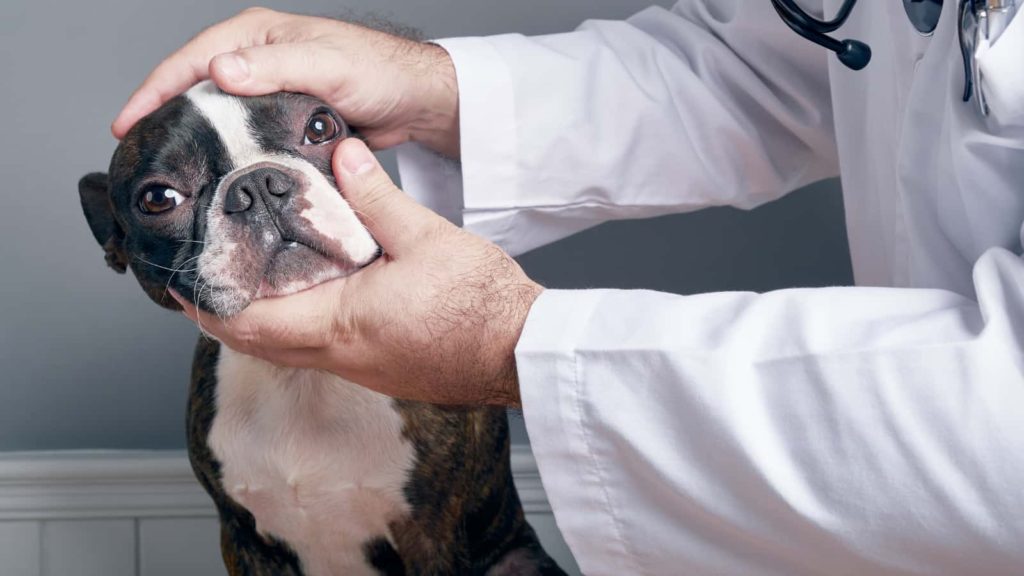Looking like James Bond in a black and white tuxedo our Boston Terriers are ready to impress. These little pups look so great they can be anyone’s date. But when looking dapper goes downhill because of a big fat red cherry eye our Boston Terriers are counting on us to help them return to their handsome selves.
Cherry eye occurs when your Boston Terrier’s third eyelid becomes irritated and inflamed causing it to turn red and swell like a cherry sticking out from the corner of your dog’s eye nearest to their muzzle. It could be large and cover a significant part of their eye, or small and only appear once and a while.

While Cherry eye is not usually very painful for our dogs it can look concerning and if left untreated it could get worse or cause other problems.
In this article, you’ll learn what causes red-eye or cherry eye in a Boston Terrier, how to know if your dog has it, and how to fix it using easy-to-follow steps that have worked for real owners.
Causes of Red Eye in a Boston Terrier
Looking into your beautiful Boston Terrier’s eyes when they are clear and healthy can make us feel as if we are looking into their soul. Our dog’s eyes can tell us a lot about how they are feeling, including when they don’t feel very well.
Disclaimer: This post may contain affiliate links. We only recommend high-quality products that are used and recommended by real owners. If you use these links to buy something we earn a small commission.
When your Bostons eyes are red there is something going on that needs your attention.
One of the most common reasons for the redness is that the Terrier is prone to a condition known as Cherry Eye.
Red-eye or Cherry eye is a disorder of the nictating membrane.
All dogs have special fibers that hold the third eyelid in place. Boston terriers are genetically weaker in these fibers making them more prone to getting cherry-eye. The cause is not completely understood, however, this can happen when they don’t get enough supply of oxygen and nutrients causing redness, and swelling. Other reasons could also include Conjunctivitis, allergies, and irritants.
Symptoms of Red Eye in a Boston Terrier
There are some early symptoms to be aware of that will alert you to your Boston Terrier beginning to have eye problems. Some of those include.
- Keeping their eye closed
- Excessive watering of the eye
- Pawing or scratching at their eye
- Rubbing their eye on furniture or the floor (as if they are trying to itch it)
- Squinting or struggling to keep eye open for long
- A red mass in the corner of their eye
One of the easiest symptoms to catch when they suffer from red-eye is the Boston’s third eyelid begins to pop out.
One of the fun facts I like to tell kids in my online classes is about how dogs have 3 eyelids. Unlike us humans who only have two, an upper and lower, dogs have 3. That third eyelid is clear and usually can’t be seen. It is there to protect their eye from allergens and debris.
Anytime your Boston Terrier suffers from red-eye or cherry eye it’s their third eyelid that is getting swollen, red, and starts draining eye fluids.

How to Prevent Cherry Eye in Boston Terriers
Unfortunately, there is no real way to prevent cherry eye in your Boston Terrier, but keeping your terrier generally healthy can go a long way in helping them from developing complications. Catching Cherry-eye early and using the massage method explained below can help prevent it from worsening.
How to Fix the Boston’s Red Eyes at Home
It is not guaranteed, but you may be able to fix your Boston’s red-eye without needing to give him medications or get surgery. The key is to detect the cherry eye early and addressed it quickly. If you do this you may be able to resolve it with little effort at home.
Here are the steps to take.
1. Make sure your dog is relaxed and calm.
2. Close your Boston Terrier’s eye.
3. Gently massage the side of the eyes and provide relaxation in that region.
4. Very gently apply pressure downwards trying to massage the red part of the eye back down under the bottom eyelid.
5. Encourage your dog to relax and rest.
6. Make sure your dog is on a healthy diet that can help reduce inflammation.
You can also use a warm clean moist cloth to cover the eye first in order to relax the eye and help reduce the inflammation.
If the Cherry eye doesn’t reduce after trying these steps or if it gets worse over the following days it is then time to take your dog to your vet.
Fixing the Boston Terrier’s Red Eye with Topical Medication
A number of prescription remedies may help, particularly if an illness or infection caused the red-eye. A doctor might prescribe Glaucoma drops to reduce pressure in the eyes. Antibiotic drops or ointments to treat an infection in the eyes.
These are simple 2-3 drops that any veterinarian will give to apply in the eyes of the Terrier 2-3 times daily, depending on how serious the redness looks.
Using Oral Medication to fix the Boston Terrier’s Red Eye
Many times, the cherry eye can happen because of infection or trauma to the eye, to fix this oral antibiotics are generally prescribed for your Boston Terrier. Anti-inflammatory is sometimes also used in case of itching.

The Surgical Method to Fix the Boston Terrier’s Red Eyes
Surgery is one of the most common and effective methods to fix Cherry eye in your Boston Terrier. Surgery can help permanently address and resolve the root cause of the problem that started the Cherry eye.
The cost of this surgery can range from $500-$800 depending on the type of surgery performed.
There are 3 different types of surgery that can help address the problem. It is important to talk to your vet about which one will work best for your dog.
The first is called the tucking method. This involves placing one stitch in such a way that it will help push and hold the gland in place. The stitch will remain permanently.
This method should work, but for some dogs, if the stitch isn’t strong enough it could break and possibly scratch your dog’s eye. If your dog also suffers from other eye problems this method may not work.
The next is the pocket method. With this technique, the surgeon removes a small wedge of tissue allowing more room for your dog’s eye to recede back in place. This is a newer method and can be fairly tricky to get the right amount of tissue removed.
The third method is the complete removal of the third eyelid gland. This used to be a very popular solution until it was discovered that doing this has the potential to cause a lot more problems. This gland is used to form tears and removing it can cause extreme dry eye which can lead to other issues for your dog.
If you choose this route you will most likely need to give your dog eye drops every day for the rest of its life.
Take care to have a good discussion with your vet about the lasting effects the surgery will have on your dog. You can be proactive and ask your vet to prescribe some topical medications as a preventative measure.
Boston Terrier Ears Complete Guide (Floppy, Infections, Problems)
While we strive to give the most accurate and helpful information about your pet’s health that we can, this article is meant to be informational only and not medical advice. Never disregard, avoid or delay in obtaining medical advice from your veterinarian or other qualified veterinary health care provider regardless of what you have read on this site or elsewhere.



